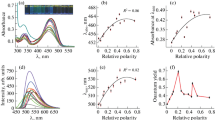Abstract
The fluorescence behavior of a calix[6]arene with a dansyl group as fluorescence marker (C6-DA) was investigated with respect to the inclusion properties of alkaloids as atropine and cocaine. A strong hypsochromic shift of the fluorescence band and a strong increase in fluorescence intensity is connected with the interaction of atropine to the lower rim of the C6-DA. The fluorescence increase is saturated at an atropine concentration above the 1:1 complex formation. Addition of cocaine to the complexed atropine-C6-DA leads to a decrease of the fluorescence intensity which could be explained by an exchange mechanism of the complexed molecules. The complexation of the atropine (the “belladonna effect”) is interpreted by electrostatic interaction (proton transfer from the carboxylic group to the nitrogen) with important contribution from hydrogen bonding by the guest OH-group.








Similar content being viewed by others
References
Valeur B, Leray I (2000) Coord Chem Rev 205(1):3–40
Schönefeld K, Barann A, Vogel K, Feller K-H, Kunze D, Müller P, Weber E (2005) Int J Environ Anal Chem 85(9–11):655
Ghoneim N, Scherrer D, Suppan P (1993) J Lumin 55:271
de Silva PA, Fox DB, Huxley AJM, Moody TS (2000) Coord Chem Rev 205(1):41
Fabbrizzi L, Licchelli M, Rabaioli G, Taglietti A (2000) Coord Chem Rev 205(1):85–108
Citterio D, Omagari M, Kawada T, Sasaki S, Suzuki Y, Suzuki K (2004) Anal Chim Acta 504(2):227–234
Gunnlaugsson T, Nieuwenhuyzen M, Richard L, Thoss V (2001) Tetrahedron Lett 42:4725–4728
Ouchi M, Shibutani Y, Yakabe K, Shono T, Shintani H, Yoneda A, Hakushi T, Weber E (1999) Bioorg Med Chem 7:1123–1126
Erk C, Göcmen A, Talanta (2000) xx 53:153–140
Leary I, Habib-Jiwan J-L, Branger C, Soumillion J-P, Valeur B (2000) J Photochem Photobiol A 135:163–169
Kele P, Orbulescu J, Calhoun TL, Gawley RG, Leblanc RM (2002) Tetrahedron Lett 43:4413–4416
Bekiari V, Judeinstein P, Lianos P (2003) J Lumin 104:13–15
Ludwig R (2005) Microchim Acta 152(1–2):1–19
Ludwig, R (2001) In: Z Asfari, V Böhmer, J Harrowfield, J Vicens (eds.) Calixarenes 2001. Kluwer Academic, pp 598–611
Casnati A, Sansone F, Ungaro R (2003) Acc Chem Res 36(4):246
Sansone F, Barboso S, Casnati A, Sciotti D, Ungaro R (1999) Tetrahedron Lett 40(25):4741
de Jong MR, Engbersen FJ, Huskens J, Reinhoudt DN (2000) Chem Eur J 6(21):4034–4040
Ikunaga T, Ikeda H, Ueno A (1999) Chem Eur J 5(9):2698–2704
Yield 93%; m.p. 170 - 173 °C; t.l.c. (SiO\(_2\), CHCl\(_3\)/EtOH 9/1) Rf \(^{\it f}\) 0.4; NMR (ppm): σ\(_{\rm H}\) 0.9 and 1.3 (br m, 54H, \(^{\it t}\)Bu), 2.9 (br s, 6H, N-CH\(_3\)), 3.4 (br s) and 4.24 (br sh) CH\(_2\)-Ar (12H), 4.5 (br sh, 12H, O-CH\(_2\)), 6.75 to 7.6 (br) and 8.6 (br) H\(_{\rm Ar}\) (18H); selected σ\(_{\rm C}\) 44.9 (N-CH\(_3\)), 71.0 (O-CH\(_2\)-amide); MS (MALDI-TOF,) 1554 (LH+); C\(_{90}\)H\(_{108}\)N\(_2\)O\(_{19}\)S calc. C 69.6, H 7.0, N 1.8, S 2.06%, found C 69.3, H 6.96, N 2.0, S 2.1%.
Friedrich M, unpublished results
Feller K-H, Schönefeld K, Ludwig R, Sens Actuators (in preparation)
Mandolini L, Ungaro R (2000) Calixarenes in action. Imperial College Press, London, UK
Schönefeld K, Henkel T, Feller K-H, Sens Actuators (in preparation)
Acknowledgments
This work is supported by the German Federal Ministry of Economy and Labour under grant No. 16IN0217 “ChemoChips.” We thank Dr. M. Friedrich (FSU Jena) for the NMR investigations. Many helpful discussions with Dr. T. Henkel (IPHT Jena) are gratefully acknowledged. Dr. U. Demme (FSU Jena, Institute of Forensic Medicine) was so kind to help us with the cocaine solutions, which we gratefully acknowledge.
Author information
Authors and Affiliations
Corresponding author
Rights and permissions
About this article
Cite this article
Schönefeld, K., Ludwig, R. & Feller, KH. Fluorescence Studies of Host–Guest Interaction of a Dansyl Amide Labelled Calix[6]arene. J Fluoresc 16, 449–454 (2006). https://doi.org/10.1007/s10895-005-0055-7
Received:
Accepted:
Published:
Issue Date:
DOI: https://doi.org/10.1007/s10895-005-0055-7




